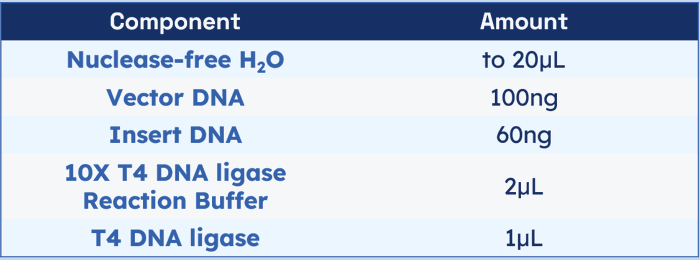Product description: T4 DNA ligase catalyzes the formation of a phosphodiester bond between 5'-phosphate and a 3'-hydroxyl groups of double-strand DNA or RNA. The enzyme repairs single-strand nick in double-strand DNA, RNA or DNA/RNA hybrids, joins DNA fragments with either cohesive or blunt termini. The T4 DNA Ligase requires ATP as a cofactor.
Resource: Recombinant E.coli
Concentration and Size: 400U/μL
Unit Definition: One unit is defined as the amount of enzyme required to give 50% ligation of 6μg of λ-HindIII DNA in 30 minutes at 16℃ in a total reaction volume of 20μL.
Storage Buffer: 10mM Tris-HCl (pH7.4, 25℃), 50mM KCl, 1mM DTT, 0.1mM EDTA, and 50% (v/v)Glyercol.
Companion Product: 10X T4 DNA Ligase Reaction Buffer, Cat#ON-158, 500mM Tris-HCl pH 7.5, 25℃, 100mM MgCl2, 10mM ATP, 100mM DTT.
1. The literature reflects the variability in ligation conditions. Blunt-end ligations generally are efficient temperatures between 15-20℃ for 4-18hr, while sticky ends are ligated effectively at room temperature (22℃) for 3hr or 4-8℃ overnight.
2. We do not recommend the use of PEG in ligations, however, due to extreme variability in the quality of PEG. In addition, the use of PEG can lead to undesirable concatemerization when cloning cDNAs, and residual PEG is inhibitory to lambda packaging reactions.
3. The desired vector: insert ratio will be 1:3. The following ligation reaction of a 5kb vector and a 1kb insert DNA.
Incubate the reaction at: room temperature for 3 h, or 4℃ overnight, or 16℃ for 4-18 h.
Storage Conditions: -20℃
Quality Assurance: Free of endonuclease, exonuclease, Nickase and RNase activities.
Physical Purity: >95% by SDS-PAGE.
Ligation and Recutting: >95% ligation of the DNA fragments, and of these ligated fragments, >95% can be recut.
